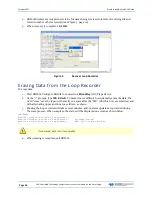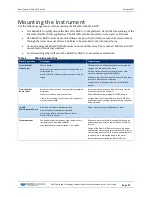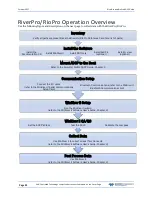
RiverPro and RioPro ADCP Guide
October 2017
EAR-Controlled Technology Subject to Restrictions Contained on the Cover Page.
Page 23
I/O Cable and Dummy Plug
The underwater connector (on the end-cap) and the I/O cable and dummy plug are molded wet-mate-able
connectors. The end-cap connector is a factory-installed item. TRDI does not recommend removing it for
any routine maintenance.
The dummy plug should be installed any time the cable is removed. Use the dummy plug when
the RiverPro/RioPro is in storage or is being handled.
To disconnect the cable:
1. Place the RiverPro/RioPro on a soft pad to protect the transducer face. Remove the Strain Relief.
2. Release the retaining strap by pulling it over the connector.
3. Grasp the cable close to the housing (see Figure 7).
4. Pull the cable straight out away from the housing with a gentle rocking motion. Do not apply any
upward force on the connector as it is being disconnected.
To connect the cable:
1. Check all pins for signs of corrosion (greenish oxidation or pitting).
2. Use light amounts of silicone lubricant (such as 3M
TM
Silicone Lubricant (Dry Type) ID No: 62-
4678-4930-3) on both the male pins and female socket to help seat the cable connectors. Wipe off
excessive silicone spray from the metal portions of the pins. Regular lubrication is required:
Apply dry type silicone lubricant prior to each connection.
3. Push the cable straight onto the connector. Attach the Strain Relief.
Figure 7.
Removing the I/O Cable
Apply dry type silicone lubricant prior to each connection.
When the cable is connected without any lubricant, excessive force is needed to fully seat or remove
the connector. This can cause several serious problems:
1. The neoprene rubber portion of the contact pin may tear from the metal pin.
2. Wiggling the cable side-to-side to overcome the friction as it is connected or disconnected may
cause the neoprene rubber to tear or create pin-holes on the side of the connector.
Any damage to the connector’s neoprene rubber may cause corrosion on current carrying
pins.
Use ONLY
silicone based lubricants.
DO NOT
use petroleum based lubricants.
















































